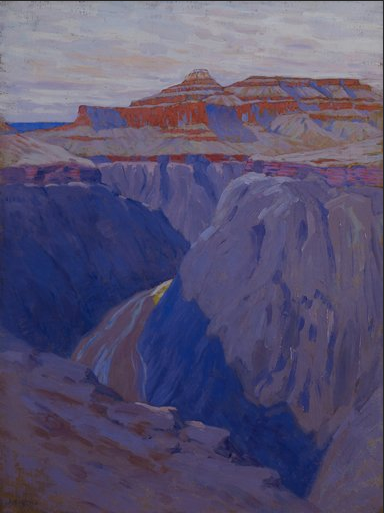Heading far west to paint the Grand Canyon in 1911 and 1912, Arthur Wesley Dow was, as usual, thinking about the Far East. For 20 years, Dow had applied the forms and harmonies of Asian art to small New England scenes, and now he had to wonder whether the trusty principles of Japonisme could help him make sense of this unfathomable canyon, which Teddy Roosevelt had made a national monument only a few years earlier.
Now two of Dow’s Grand Canyon paintings from that adventure are on view at Mia: the museum’s own The Destroyer, in Gallery 301, and the wonderfully kaleidoscopic Cosmic Cities (above) in “Seeing Nature: Landscape Masterworks from the Paul G. Allen Family Collection” (now through September 18 in the Target Galleries). Together, they show Dow’s Japoniste tendencies holding fast even in the face of this vast new subject.
Born in Ipswitch, Massachusetts, in 1857, Dow encountered Japanese woodcuts firsthand in 1891 at Boston’s Museum of Fine Arts, much the way Twin Citians come to see original prints in Mia’s Print Study Room. He became an instant zealot. The elements of Japanese printmaking—simplified shapes, flat colors, patterns of lights and darks, images sliced off at the picture’s edge—emphasized the two-dimensional surface of the paper, as opposed to creating the illusion of depth. This seemed to Dow a more pure and honest way of depicting nature, and making art objects with honesty was a hallmark of the Arts and Crafts movement at the time. Through several important teaching posts and his own Ipswitch Summer School of Art, which he ran from 1891 to 1907, Dow revolutionized the look of American handicraft in the early 1900s, including pottery, metalwork, weaving, photographs, and prints.

Edna Boies Hopkins’s Spider Lily, c. 1905-17. Dow introduced Hopkins to Japanese woodcuts at Pratt Institute in New York in 1899.

Bertha Lum’s Pines by the Sea from 1912. Like generations of Americans, Lum learned to make woodcuts from Dow’s landmark textbook, Composition (1891).
Dow’s precepts echo repeatedly in the works of his followers, including several in Mia’s collection: the flattened flower in Edna Boies Hopkins’s Spider Lily (c. 1905-17); the abstracted trees in Bertha Lum’s Pines by the Sea (1912); the sweeping curve in Alvin Langdon Coburn’s photograph of Dragon Creek, taken in 1903 from Dow’s Ipswitch studio.
Dow’s most famous pupil was Georgia O’Keeffe, whose stylized Black Iris VI (1936) is also in the “Seeing Nature” show. Her classes with Dow at Columbia University’s Teachers College in New York in 1914 and 1916 affirmed her inclination to express herself through the harmonies she found in nature. “I had a technique for handling oil and watercolor easily,” she once said. “Dow gave me something to do with it.”

Also in the “Seeing Nature” show: Georgia O’Keeffe’s Black Iris VI from 1936. Dow taught O’Keeffe, too.
Writing in The Art That Is Life: The Arts & Crafts Movements in America, 1875-1920, Joy Cattanach Smith said Dow taught his students to treat landscape “first as a design, afterward as a picture.” That seems to have been his approach with The Destroyer and Cosmic Cities, which were among the 17 Grand Canyon paintings he unveiled in New York in 1913. Using the tenets of Japanese composition he espoused at every turn, Dow interpreted this “geologic Babylon,” as he called it, in terms of colorful, simplified forms.
The Destroyer gets its name from the curving Colorado River wearing a destructive path through the rock. The cliffs have been reduced to masses of color, their faces as smooth as grape chewing gum. The diagonals lead our eye to what looks like a distant kingdom, done in a dark-light pattern of salmon and putty.

Alvin Langdon Coburn’s The Dragon from 1903. Coburn studied photography at Dow’s summer school, and applied Dow’s Japoniste tenets to this soft-focus, serpentine creek.
The artist became even more decorative in Cosmic Cities, which uses the aerial vantage point and high horizon line seen in Japanese ukiyo-e prints. Looming in from the left edge is a linear stack of paprika-colored bands, contrasting with the soft, slanted shapes beyond. These resemble a sea of tutus—perhaps one reason O’Keeffe called Dow’s Grand Canyon pictures “pretty.” Dow flattened the picture plane by keeping the purple paint equally intense at the top and the bottom, minimizing the sense of atmospheric perspective.

Mia’s own Dow painting, The Destroyer (1911-13), resulted from the same Grand Canyon sojourn as Cosmic Cities in the “Seeing Nature” exhibition.
Dow went west hoping to give the art world something new, something beyond his quiet “New England marshes,” he said, which were feeling outmoded. (In 1913, the same year he showed his Grand Canyon works, New York hosted the avant-garde Armory Show.) Dow clearly liked his new western subject and returned there in 1919. He was injured when he fell off a horse, however, and died just three years later, at age 65.
Top image: Arthur Wesley Dow, Cosmic Cities, Grand Canyon of Arizona, 1912. Courtesy of the Paul G. Allen Family Collection.



